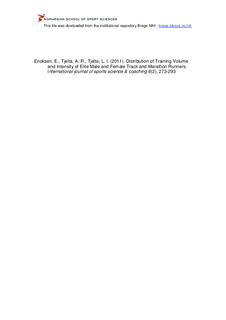| dc.contributor.author | Enoksen, Eystein | |
| dc.contributor.author | Tjelta, Asle Rønning | |
| dc.contributor.author | Tjelta, Leif Inge | |
| dc.date.accessioned | 2011-12-07T08:12:11Z | |
| dc.date.available | 2011-12-07T08:12:11Z | |
| dc.date.issued | 2011 | |
| dc.identifier | Seksjon for fysisk prestasjonsevne / Department of Physical Performance | |
| dc.identifier.citation | International Journal of Sports Science & Coaching. 2011, 6(2), 273-293 | no_NO |
| dc.identifier.issn | 1747-9541 | |
| dc.identifier.uri | http://hdl.handle.net/11250/170867 | |
| dc.description | © Multi Science Publishing | no_NO |
| dc.description.abstract | The aim of this study was to compare training volume and the distribution
of training intensity of six of the best long-distance runners in Norway from
the last decade.
Three international-level long-distance runners (two males and one
female) and three marathon runners (one male and two females) were
included. The runners’ training diaries for one of the seasons they
competed in an international championship were analysed. The reported
running volume (km/week) was used to estimate the distribution of training
at the prescribed intensity zones in representative weeks in the preparation
period and in the competition season.
During the preparation period (November - February) the marathon
runners ran an average of 186.6 ± 25.7 km/week and the track runners 161
± 11 km/week. For all runners, 80 ± 5% of the weekly training distance
(km/week) in this period was continuous running with a heart rate (HR)
between 65-82% of maximum. The remaining 20% of total training volume
(km/week) was performed at intensities near and above the anaerobic
threshold (82-92% of HRmax). This was done in three to five weekly
interval sessions or continuous running sessions. All athletes ran 11 - 13
sessions per week. The training volume (km/week) in the pre-competition
period and the competition season did not differ much from the volume in
the preparation period. The track runners increased the amount of highintensity
training at specific race pace in the pre-competition period (March
and April), and in the track competition season (May - September). | no_NO |
| dc.language.iso | eng | no_NO |
| dc.publisher | Multi-science | no_NO |
| dc.subject | aerobic capacity | no_NO |
| dc.subject | anerobic threshold | no_NO |
| dc.subject | exercise intensity | no_NO |
| dc.subject | interval training | no_NO |
| dc.subject | long-distance running | no_NO |
| dc.subject | periodisation | no_NO |
| dc.subject | training diary | no_NO |
| dc.title | Distribution of training volume and intensity of elite male and female track and marathon runners | no_NO |
| dc.type | Journal article | no_NO |
| dc.type | Peer reviewed | no_NO |
| dc.subject.nsi | VDP::Social science: 200::Social science in sports: 330::Physical education and sport psychology: 333 | |
| dc.source.pagenumber | 273-293 | no_NO |
| dc.source.volume | 6 | no_NO |
| dc.source.journal | International Journal of Sports Science & Coaching | no_NO |
| dc.source.issue | 2 | no_NO |
